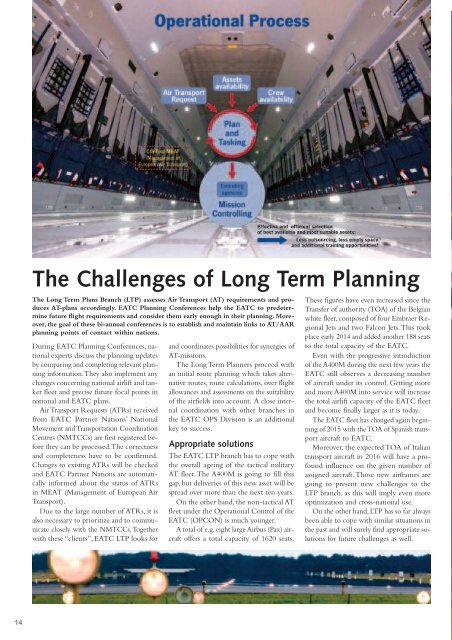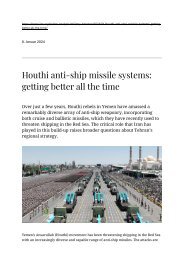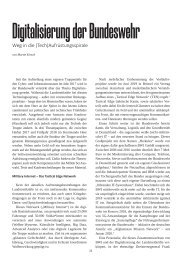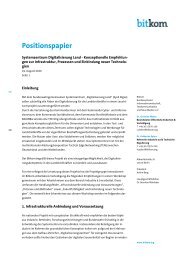EATC
Create successful ePaper yourself
Turn your PDF publications into a flip-book with our unique Google optimized e-Paper software.
The Challenges of Long Term Planning<br />
The Long Term Plans Branch (LTP) assesses Air Transport (AT) requirements and produces<br />
AT-plans accordingly. <strong>EATC</strong> Planning Conferences help the <strong>EATC</strong> to predetermine<br />
future flight requirements and consider them early enough in their planning. Moreover,<br />
the goal of these bi-annual conferences is to establish and maintain links to AT/AAR<br />
planning points of contact within nations.<br />
During <strong>EATC</strong> Planning Conferences, national<br />
experts discuss the planning updates<br />
by comparing and completing relevant planning<br />
information.They also implement any<br />
changes concerning national airlift and tanker<br />
fleet and precise future focal points in<br />
national and <strong>EATC</strong> plans.<br />
Air Transport Requests (ATRs) received<br />
from <strong>EATC</strong> Partner Nations’ National<br />
Movement and Transportation Coordination<br />
Centres (NMTCCs) are first registered before<br />
they can be processed.The correctness<br />
and completeness have to be confirmed.<br />
Changes to existing ATRs will be checked<br />
and <strong>EATC</strong> Partner Nations are automatically<br />
informed about the status of ATRs<br />
in MEAT (Management of European Air<br />
Transport).<br />
Due to the large number of ATRs, it is<br />
also necessary to prioritize and to communicate<br />
closely with the NMTCCs.Together<br />
with these “clients”, <strong>EATC</strong> LTP looks for<br />
and coordinates possibilities for synergies of<br />
AT-missions.<br />
The Long Term Planners proceed with<br />
an initial route planning which takes alternative<br />
routes, route calculations, over flight<br />
allowances and assessments on the suitability<br />
of the airfields into account. A close internal<br />
coordination with other branches in<br />
the <strong>EATC</strong> OPS Division is an additional<br />
key to success.<br />
Appropriate solutions<br />
The <strong>EATC</strong> LTP branch has to cope with<br />
the overall ageing of the tactical military<br />
AT fleet. The A400M is going to fill this<br />
gap, but deliveries of this new asset will be<br />
spread over more than the next ten years.<br />
On the other hand, the non-tactical AT<br />
fleet under the Operational Control of the<br />
<strong>EATC</strong> (OPCON) is much younger.<br />
A total of e.g. eight large Airbus (Pax) aircraft<br />
offers a total capacity of 1620 seats.<br />
These figures have even increased since the<br />
Transfer of authority (TOA) of the Belgian<br />
white fleet, composed of four Embraer Regional<br />
Jets and two Falcon Jets.This took<br />
place early 2014 and added another 188 seats<br />
to the total capacity of the <strong>EATC</strong>.<br />
Even with the progressive introduction<br />
of the A400M during the next few years the<br />
<strong>EATC</strong> still observes a decreasing number<br />
of aircraft under its control. Getting more<br />
and more A400M into service will increase<br />
the total airlift capacity of the <strong>EATC</strong> fleet<br />
and become finally larger as it is today.<br />
The <strong>EATC</strong> fleet has changed again beginning<br />
of 2015 with the TOA of Spanish transport<br />
aircraft to <strong>EATC</strong>.<br />
Moreover, the expected TOA of Italian<br />
transport aircraft in 2016 will have a profound<br />
influence on the given number of<br />
assigned aircraft. Those new airframes are<br />
going to present new challenges to the<br />
LTP branch, as this will imply even more<br />
optimization and cross-national use.<br />
On the other hand, LTP has so far always<br />
been able to cope with similar situations in<br />
the past and will surely find appropriate solutions<br />
for future challenges as well.<br />
14















